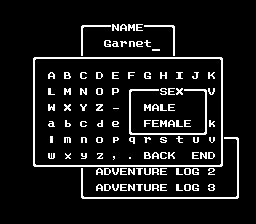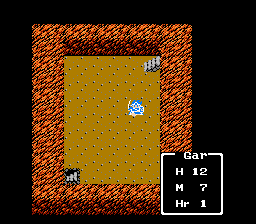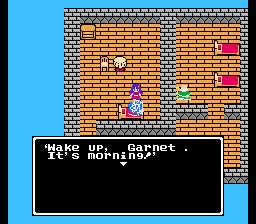Retro Replay Review
Gameplay
Dragon Warrior III builds upon the turn-based combat formula of its predecessors with a wealth of customization options that keep each playthrough feeling fresh. From the outset, you control Ortega’s son, venturing across an expansive overworld filled with random encounters, dungeons, towns, and secrets. Combat emphasizes strategy: you issue commands to each party member, balancing offensive spells, physical attacks, healing magic, and support skills. The pacing strikes a satisfying balance between exploration, battle, and resource management.
(HEY YOU!! We hope you enjoy! We try not to run ads. So basically, this is a very expensive hobby running this site. Please consider joining us for updates, forums, and more. Network w/ us to make some cash or friends while retro gaming, and you can win some free retro games for posting. Okay, carry on 👍)
One of the standout features is the flexible job system. Early on, you recruit characters in six distinct classes—soldier, fighter, merchant, goof-off, pilgrim, and wizard—and later unlock the sage class once characters reach level 20. Switching a character’s class resets their level and halves their stats but grants them all prior abilities, enabling you to craft hybrid heroes capable of both potent spellcasting and formidable melee prowess. This encourages experimentation and long-term planning, as you decide which class combinations best complement your party’s composition.
The day/night cycle adds another layer of immersion and tactical consideration. As you explore, time passes realistically: shops close at night, certain characters only appear during specific hours, and enemy spawn rates can shift based on the hour. Planning your route through towns and dungeons requires attention to the clock, injecting variety into routine fetch quests and fortress raids. While the random encounter rate can feel unforgiving by modern standards, it also ensures that every step outside a safe zone carries a sense of danger and reward.
Inventory and equipment management feel suitably robust for an NES-era title. Weapons, armor, and accessories populate shops and treasure chests, and choosing the right gear for each class is crucial to survival. Money can be tight early, especially if you splurge on high-tier equipment or healing items, so you’ll be constantly weighing whether to save for a powerful sword or upgrade your party’s defenses. This economic juggling act reinforces the importance of preparing adequately before every boss fight.
Graphics
Given its 1988 release on the Famicom and later NES ports, Dragon Warrior III’s visuals reflect the hardware’s trademark 8-bit charm. Sprites are crisp and expressive, with each class sporting distinctive pixel art designs that convey personality despite limited color palettes. Towns, castles, and villages feature unique roof tiles and wall patterns, making each locale memorable and aiding navigation across the sprawling map.
While the top-down perspective and blocky tiles might appear dated next to modern RPGs, the game’s art direction excels at maximizing clarity. Enemy sprites range from slimes to colossal bosses like Baramos, each animated with simple but effective loops. The color contrast between characters, monsters, and terrain ensures that battles remain readable, even when the screen fills with spell effects. Nostalgic players will find the retro aesthetic part of the game’s enduring appeal.
Environmental variety is also noteworthy. Traversing forests, deserts, mountains, and shorelines all yield distinct backdrops, and dungeons use lighting differences (such as darker hues for caverns) to signal increased danger. Town maps incorporate decorative elements—fountains, signposts, and market stalls—that break visual monotony. Despite hardware constraints, Dragon Warrior III maintains a coherent and inviting world brimming with detail.
On ports to handheld systems and digital re-releases, graphical enhancements like refined fonts and palette adjustments have been applied, breathing fresh life into the original designs. While purists may prefer the authentic 8-bit sprites, these modern touches can improve readability and reduce eye strain without sacrificing the core visual identity. Whether you choose the classic or updated version, the art style remains a highlight of the experience.
Story
Dragon Warrior III’s narrative serves as both a prequel and a finale to the original trilogy. You play Ortega’s son, tasked by the king to vanquish Baramos, the very devil responsible for unleashing monsters across the land. Early cutscenes are sparse by today’s standards, but the sense of destiny and familial legacy resonates strongly with fans. Being the descendant of the legendary Erdrick (Loto) imbues your quest with mythic significance from the opening minutes.
As you recruit companions and traverse the world, NPC dialogues flesh out the political intrigue, regional customs, and hidden lore. Villagers speak of lost artifacts once wielded by Erdrick, prompting side journeys that expand the epic scope. Despite simple prose, character interactions convey warmth, humor, and occasional pathos—whether you’re comforting a grieving widow, negotiating bribe costs with a merchant, or trading barbs with a goof-off recruit.
Major plot beats—discovering the legacy of Erdrick’s equipment, uncovering Baramos’s fortress, and confronting Ortega’s fate—are spaced to keep momentum high. Boss battles often feel like proper climaxes, punctuated by memorable backdrops and thematic music shifts. While the dialogue tree is linear and the overarching goal remains steady, smaller quests and the job-switching mechanic allow you to craft your own narrative arcs, from forging mighty sages to creating battle-hardened warriors.
The story’s pacing may feel brisk for RPG veterans used to sprawling modern epics, but Dragon Warrior III thrives on economy. Each town offers new revelations, every dungeon reveals pieces of the grander puzzle, and optional side content—from secret bosses to hidden spells—rewards inquisitive players. This blend of main-quest focus with exploratory freedom ensures that the narrative never stagnates.
Overall Experience
Dragon Warrior III stands as a milestone in JRPG history, offering depth and replayability rare for its era. The combination of an open world, flexible job system, day/night cycle, and engaging story encourages multiple playthroughs. You’ll find yourself experimenting with party compositions, hunting for equipment, and tackling optional bosses long after Baramos falls. The game’s design rewards both strategic planning and spontaneous exploration.
While modern conveniences—automaps, fast travel, quest logs—are absent, the sense of accomplishment derived from charting your own course remains unmatched. The random encounter rate demands patience and adaptability, but it also infuses each journey with stakes. Enduring a gauntlet of goblins, skeletons, and slimes to reach a hidden shrine or rare merchant feels genuinely heroic in a way that polished “auto-battle” systems can’t replicate.
Accessibility may pose a challenge for newcomers, as the game presumes familiarity with menu navigation, grinding mechanics, and Japanese-to-English localization quirks. However, for fans of classic RPGs or those curious about the genre’s roots, Dragon Warrior III delivers a fulfilling immersion into high-stakes fantasy. Its legacy endures in countless successors that adopted its job system and class-switch mechanics.
In sum, Dragon Warrior III offers a timeless adventure that balances narrative, customization, and challenge. Whether you’re revisiting this chapter of Erdrick’s saga or experiencing it for the first time, the game’s blend of strategic depth and nostalgic charm makes it a standout title—one that continues to influence role-playing games decades after its release.
 Retro Replay Retro Replay gaming reviews, news, emulation, geek stuff and more!
Retro Replay Retro Replay gaming reviews, news, emulation, geek stuff and more!









Reviews
There are no reviews yet.